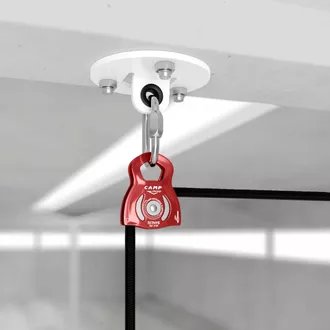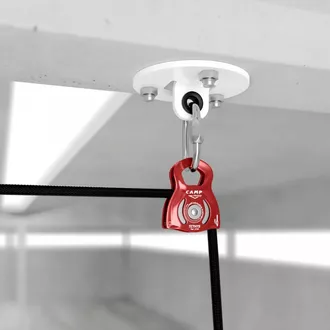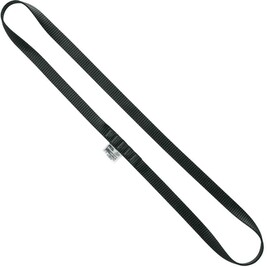Mobile anchor with anchor plates









Anchor point set with a pulley system and anchor plates:
Everything you need to install a certified mobile anchor point.
It will allow you to set up acrobatic and aerial dance equipment in seconds, safely and without the need for ladders nor scaffolding.
This set is designed to be installed in structures with a concrete ceiling or beam. It can also be used for an installation on wooden beams, including when you cannot pass over your beam. If you want to set up this type of system on a beam where you can't pass around it with the straps, we have another dedicated model: Mobile anchoring system for beam.
Contents of the aerial anchor point set:
- 3 anchor plates.
- 2 pulleys.
- 2 oval steel carabiners with safe closure.
- 2 Delta quick links in 8mm.
- 1 ballast bag in which you will need to put 2 to 3 kilos of sand or gravel.
- 1 iridium cord, diameter 10.5mm, with certified sewn loop.
- Landing mattress not included in this set.
The length of the rope must be specified at the time of your purchase by choosing it from the options. To determine the correct length of rope you need, multiply the height of the anchor point above the ground by 2 and to add its distance to the wall to which the ground plate is fixed: A x 2 + B.
You will find these lengths on our visual below:

As for the anchor plates, they come with screws and bolts. The screws are to be used for installation on a wooden beam and the bolts if your installation is on a concrete wall or beam. For an installation in concrete you will need to carry out a chemical seal (not included in this set).
On some of our visuals, Play's certified landing mat appears. It is not supplied with this set, it is there for demonstration purposes only.














Hello, do you know how long the rope lasts?
The lifespan of CAMP's 10.5mm Iridium Static Rope depends on several factors, including frequency of use, conditions of use and maintenance. Maximum theoretical lifespan:
- - Storage before use: up to 5 years under optimal conditions.
- - Use: up to 10 years, depending on intensity and conditions of use.
- - Total lifespan: limited to 15 years, including storage and use.
Factors influencing lifespan:- - Frequency and intensity of use: intensive use reduces lifespan.
- Environmental conditions: Exposure to UV, humidity, chemicals and sharp edges can accelerate wear.- - Maintenance: Regular cleaning with clean water and drying in the shade prolongs the lifespan.
Recommendations: Regular Inspection : Before each use, check the condition of the rope for signs of wear, cuts or abrasion. Replacement: If the rope shows visible damage or has suffered a significant fall, it is advisable to replace it immediately.What resistance force in kg must the support (beam, etc.) be able to support for such an installation?
Good morning, Thank you for your question regarding the support strength for installing our anchor systems. The strength capacity of the beam or any other structure depends on several factors, such as the apparatus you intend to install, the user's skill level, and additional loads (for example, the presence of an occupied floor above the practice area). General Recommendation: We generally recommend a beam or supporting structure capable of supporting a load of at least 1000 kg (1 tonne) to ensure safety when installing this type of anchoring system. However, this rating may vary depending on the specifics of your installation. Professional consultation: To ensure a safe installation, it is strongly recommended to consult a building professional, such as an architect or carpenter. These experts will be able to assess the structure based on your specific needs and the equipment to be installed. It is also helpful to show them a video or technical documents relating to the equipment so they can better understand the types of forces exerted on the anchor points. Please do not hesitate to contact us with any further questions or requests for advice.